© previous project next project¨
123 sq.m.
1320 sq.ft.
The house locates in front of the spacious rice fields. We designed it in consideration of the relation between the rich environment and the clientfs life.
Three small huts are put on the flat house of the ground floor.
The ground floor is an open space where the client enjoys the time with friends. In this space, the direction of the activity is parallel to the scenery. So, as a backdrop of the activity, they are somewhat conscious of the scenery.
Three huts are the private spaces. Each hut has windows in four directions for introducing light and wind, so those are just small solitary houses in the nature. The alternate disposition of the huts is effective for receiving the light and wind at maximum.
The huts face directly to the scenery so that they would be strongly conscious of it.
In each hut, the finish material and how to cut out the view are different. Therefore, the sense of distance between the scenery and the client becomes diverse.
The western hut is finished in wood with familiar atmosphere corresponding to the function of the daily-use bedrrom.
In the central hut which interior is covered with metal, the scenery is cut as a big picture flame. In this hut, the scenery is emphasized and they are strongly conscious of the scenery.
The interior of the eastern hut is finished in mirror and paint with strong gloss so that the scenery would be reflect in the surface as if the exterior were introduced in the interior. Therefore, the scenery becomes a kind of the finish materials. While, the very conservative materials such as a wool carpet and a Andean Rose wood are also used. The mix of the scenery as the finish material and the conservative materials produces the confused relation in the finish of space, as a result, it accelerated the dismantling of the scenery.
Since the color and material of the exterior appearance are usual in the area and the volume of the architecture is similar to the surrounding houses, the continuity between the townscape is generated. At the same time, the composition of architecture is peculiar, therefore, the architecture intends to get the independence that is so delicate that it would generate no sense of incongruity in the townscape.
Location : Nigata-city, Nigata, Tokyo
Architect : Daigo Ishii + Future-scape Architects
Structure Engineer : Oga Structure Design Office
Cooperation : Hiroyuki Kato, Michiko Aikawa, Hirofumi Ikeda, Shinpei Tomo, Arata Tamura, Apartment
Mechanical Engineer: Akeno Mechanical laboratory
Construction : Ueki-gumi Construction Company
@

@@
@@
@
@
@
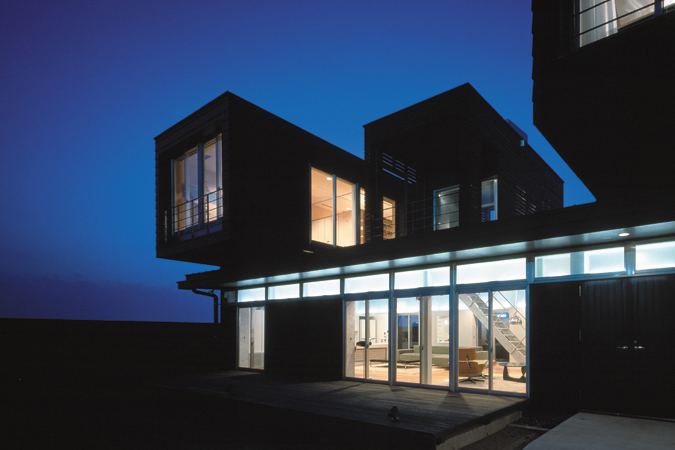 The night view of the exterior appearance seen from the south side. There are three huts on the long and narrow space of the first floor. Photo: Koichi Torimura.
The night view of the exterior appearance seen from the south side. There are three huts on the long and narrow space of the first floor. Photo: Koichi Torimura.
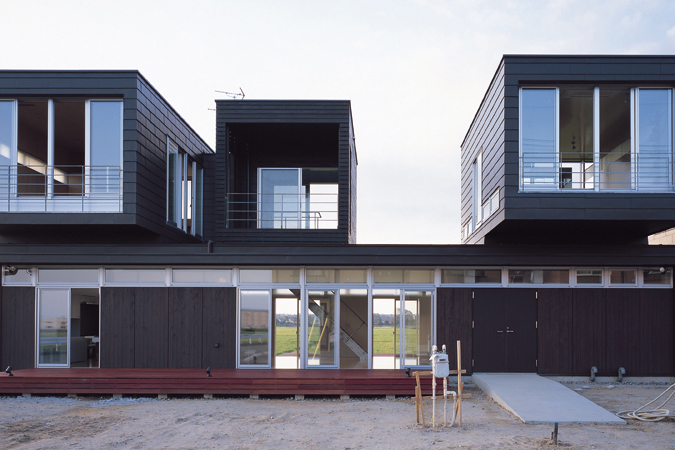 The evening view seen from the south side. See the scenery of the rice fields on the other side and the sky through the glass. Photo: Isamu Hirukawa.
The evening view seen from the south side. See the scenery of the rice fields on the other side and the sky through the glass. Photo: Isamu Hirukawa.
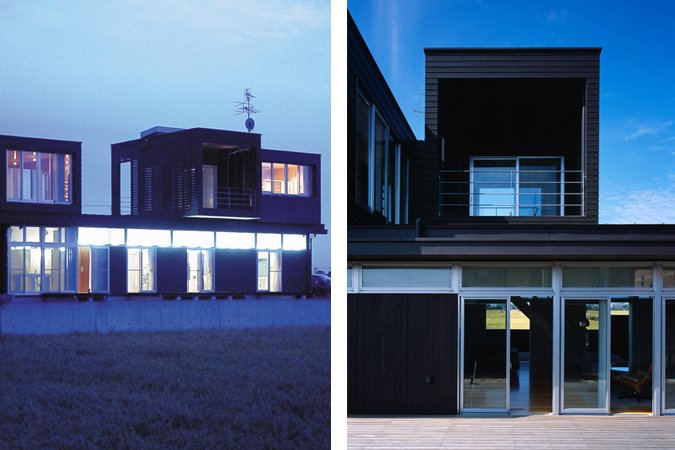 (Left) The evening view seen from the north side. (Right) A part of the exterior appearance of the south side. Photo: Koichi Torimura.
(Left) The evening view seen from the north side. (Right) A part of the exterior appearance of the south side. Photo: Koichi Torimura.
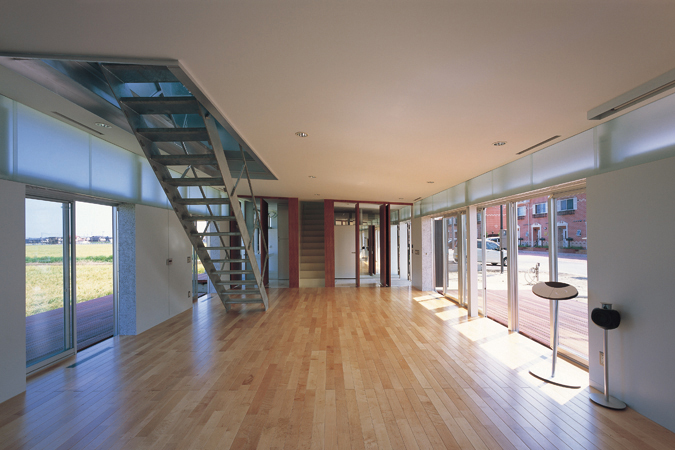 See the LDK on the 1st floor. The two stairs that go up to the second floor are accents. The LDK connect with the terrace and garden on both sides. Photo: Isamu Hirukawa
See the LDK on the 1st floor. The two stairs that go up to the second floor are accents. The LDK connect with the terrace and garden on both sides. Photo: Isamu Hirukawa
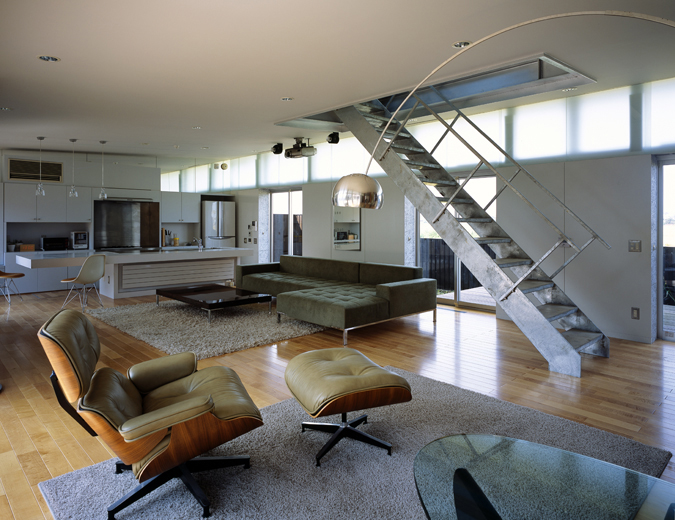 See the LDK on the first floor. The concrete table is floating in the air. See the rice field scenery beyond the stairs leading up to the huts in the west and in the center on the second floor. Photo: Koichi Torimura
See the LDK on the first floor. The concrete table is floating in the air. See the rice field scenery beyond the stairs leading up to the huts in the west and in the center on the second floor. Photo: Koichi Torimura
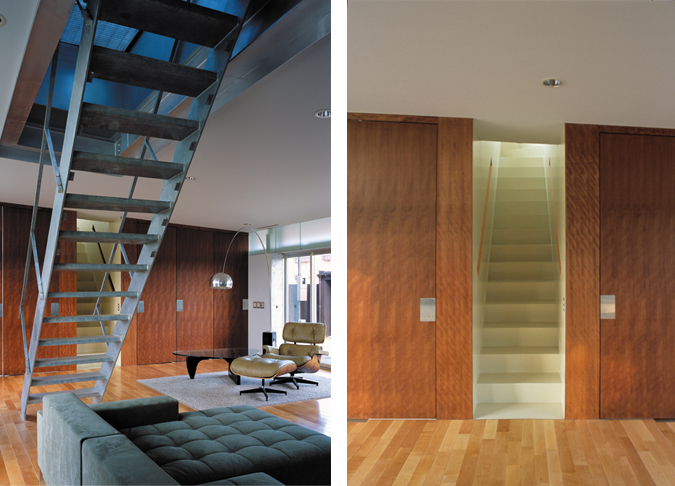 (Left) See the two stairs of the LDK on the first floor. Photo: Koichi Torimura (Right) See the stairs going up to the eastern hut from the LDK on the 1st floor.
(Left) See the two stairs of the LDK on the first floor. Photo: Koichi Torimura (Right) See the stairs going up to the eastern hut from the LDK on the 1st floor.
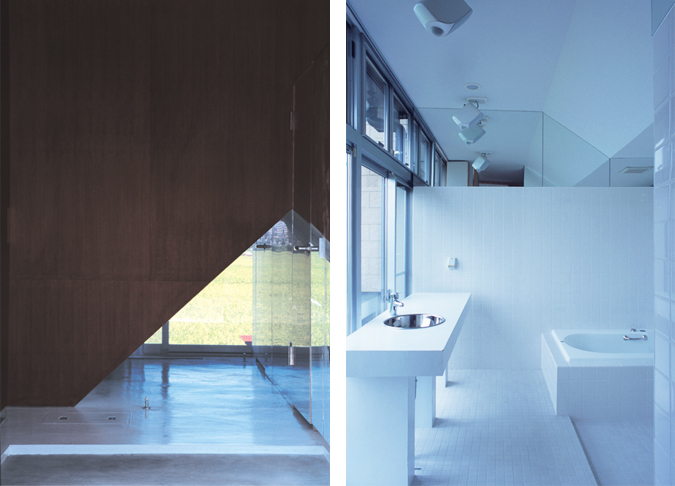 (Left) See the rice field scenery from the entrance on the first floor. (Right) The bathroom on the first floor. The window on the left is open to the rice field scenery.
(Left) See the rice field scenery from the entrance on the first floor. (Right) The bathroom on the first floor. The window on the left is open to the rice field scenery.
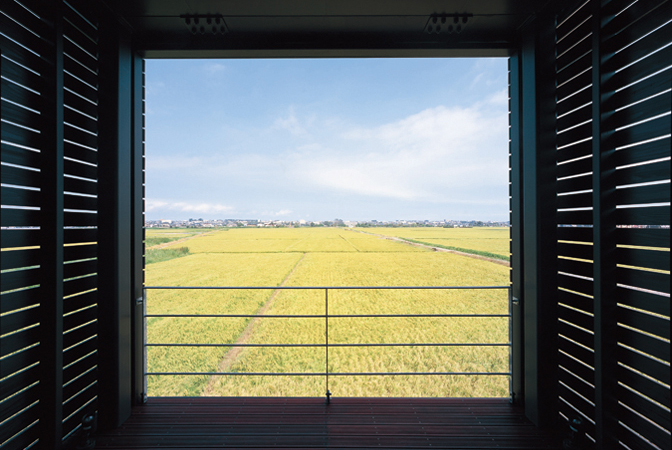 See the rice field scenery seen from the terrace of the central hut on the 2nd floor. It faces the rice field scenery that looks like cut-out in a frame. Photo: Isamu Hirukawa
See the rice field scenery seen from the terrace of the central hut on the 2nd floor. It faces the rice field scenery that looks like cut-out in a frame. Photo: Isamu Hirukawa
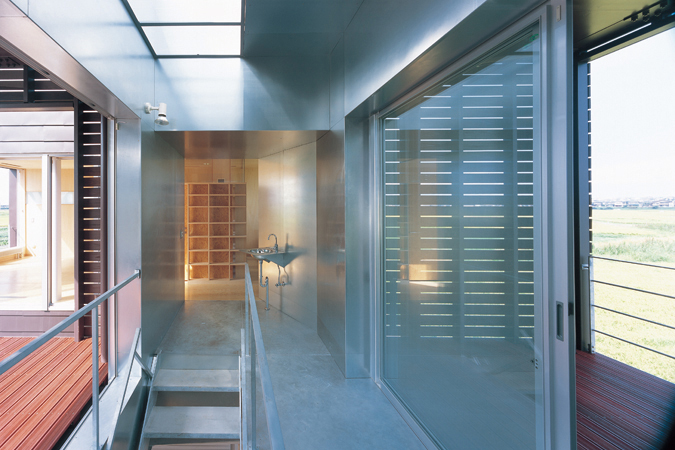 See the central hut on the second floor. It has windows in four directions so that they could feel the light of various times. Photo: Isamu Hirukawa.
See the central hut on the second floor. It has windows in four directions so that they could feel the light of various times. Photo: Isamu Hirukawa.
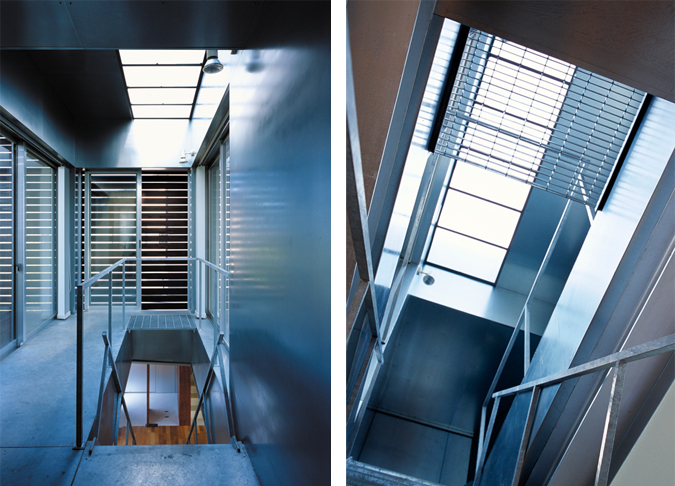 (Left) See the central hut on the 2nd floor. The interior finished with the galvanized steel plate is covered with a gapped cedar board. Photo: Koichi Torimura . (Right) Look up the central hut from the first floor.
(Left) See the central hut on the 2nd floor. The interior finished with the galvanized steel plate is covered with a gapped cedar board. Photo: Koichi Torimura . (Right) Look up the central hut from the first floor.
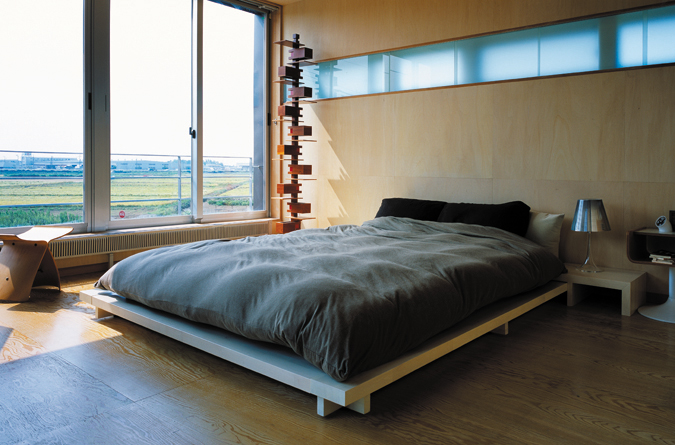 See the interior in the western hut. The private room A is a bedroom for the owner couple. It is finished with wood material according to the function of the room. Photo:Koichi Torimura
See the interior in the western hut. The private room A is a bedroom for the owner couple. It is finished with wood material according to the function of the room. Photo:Koichi Torimura
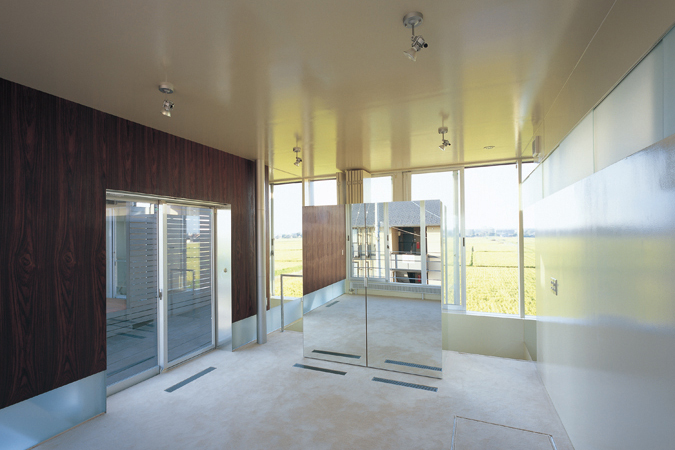 See the private room B in the eastern hut on the second floor. Light enters through windows in four directions. The scenery of the rice field is reflected on the glossy ceiling and mirrors, and the scenery becomes the finishing material. Photo:Isamu Hirukawa
See the private room B in the eastern hut on the second floor. Light enters through windows in four directions. The scenery of the rice field is reflected on the glossy ceiling and mirrors, and the scenery becomes the finishing material. Photo:Isamu Hirukawa
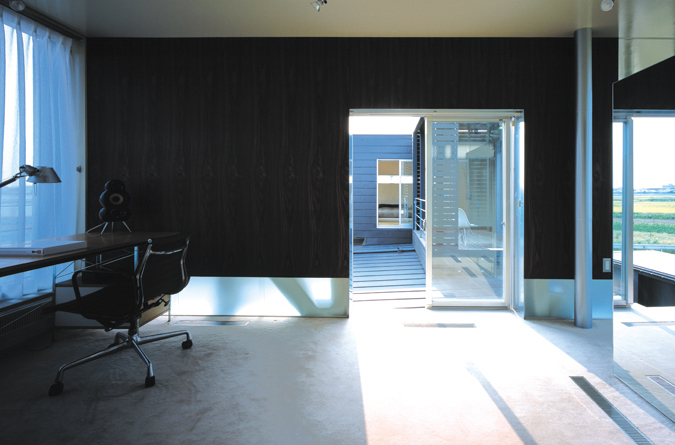 See the interior of the eastern hut on the second floor and the central hut and the westeran hut beyond the window. Photo:Koichi Torimura
See the interior of the eastern hut on the second floor and the central hut and the westeran hut beyond the window. Photo:Koichi Torimura
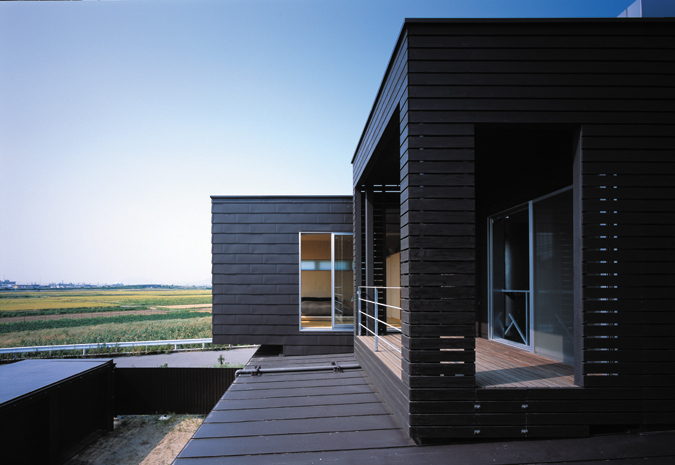 See the central hut from the eastern hut on the second floor. Each hut is disposed so as not to interfere in consideration with how to introduce wind and light in the interior. Photo: Koichi Torimura
See the central hut from the eastern hut on the second floor. Each hut is disposed so as not to interfere in consideration with how to introduce wind and light in the interior. Photo: Koichi Torimura
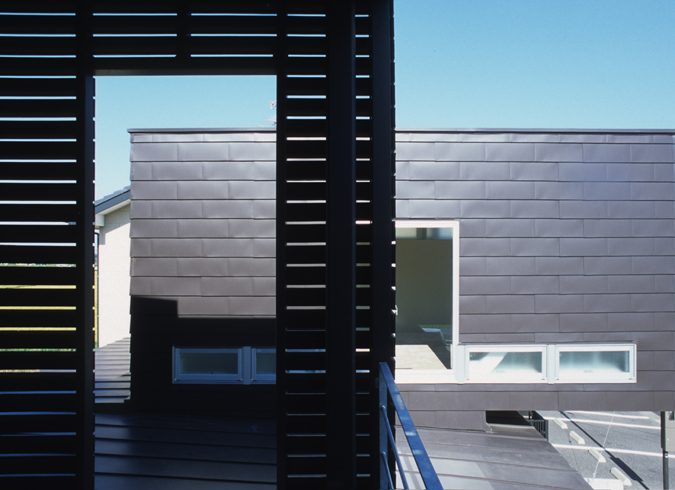 See the eastern hut from the central hut on the second floor.
See the eastern hut from the central hut on the second floor.
@
@
@
@
@
@
@
@
@
@
@
@